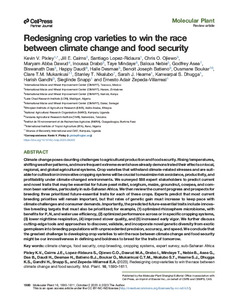| dc.contributor.author | Pixley, K.V. |
| dc.contributor.author | Cairns, J. |
| dc.contributor.author | Lopez-Ridaura, S. |
| dc.contributor.author | Ojiewo, C.O. |
| dc.contributor.author | Dawud, M.A. |
| dc.contributor.author | Drabo, I. |
| dc.contributor.author | Mindaye, T. |
| dc.contributor.author | Nebie, B. |
| dc.contributor.author | Asea, G. |
| dc.contributor.author | Das, B. |
| dc.contributor.author | Daudi, H. |
| dc.contributor.author | Desmae, H. |
| dc.contributor.author | Batieno, B.J. |
| dc.contributor.author | Boukar, O. |
| dc.contributor.author | Mukankusi-Mugisha, C. |
| dc.contributor.author | Nkalubo, S. |
| dc.contributor.author | Hearne, S. |
| dc.contributor.author | Dhugga, K.S. |
| dc.contributor.author | Gandhi, H. |
| dc.contributor.author | Snapp, S. |
| dc.contributor.author | Zepeda-Villarreal, E.A. |
| dc.date.accessioned | 2023-10-25T10:20:39Z |
| dc.date.available | 2023-10-25T10:20:39Z |
| dc.date.issued | 2023-10 |
| dc.identifier.citation | Pixley, K.V., Cairns, J., Lopez-Ridaura, S., Ojiewo, C.O., Dawud, M.A., Drabo, I., ... & Zepeda-Villarreal, E.A. (2023). Redesigning crop varieties to win the race between climate change and food security. Molecular Plant, 16(10), 1590-1611. |
| dc.identifier.issn | 1674-2052 |
| dc.identifier.uri | https://hdl.handle.net/20.500.12478/8312 |
| dc.description.abstract | Climate change poses daunting challenges to agricultural production and food security. Rising temperatures, shiftingweatherpatterns,andmore frequent extremeeventshave alreadydemonstratedtheir effectsonlocal, regional, and global agricultural systems. Crop varieties thatwithstand climate-related stresses and are suitable for cultivation in innovative croppingsystemswillbe crucial tomaximize risk avoidance, productivity, and profitability under climate-changed environments. We surveyed 588 expert stakeholders to predict current and novel traits that may be essential for future pearl millet, sorghum, maize, groundnut, cowpea, and common bean varieties, particularly in sub-SaharanAfrica.Wethen reviewthe current progress and prospects for breeding three prioritized future-essential traits for each of these crops. Experts predict that most current breeding priorities will remain important, but that rates of genetic gain must increase to keep pace with climate challenges and consumer demands. Importantly, the predicted future-essential traits include innovative breeding targets that must also be prioritized; for example, (1) optimized rhizosphere microbiome, with benefits for P, N, andwater use efficiency, (2) optimized performance across or in specific cropping systems, (3) lower nighttime respiration, (4) improved stover quality, and (5) increased early vigor. We further discuss cutting-edge tools and approaches to discover, validate, and incorporate novel genetic diversity fromexotic germplasminto breeding populations with unprecedented precision, accuracy, and speed.We conclude that the greatest challenge to developing crop varieties to win the race between climate change and food security might be our innovativeness in defining and boldness to breed for the traits of tomorrow. |
| dc.format.extent | 1590-1611 |
| dc.language.iso | en |
| dc.subject | Food Security |
| dc.subject | Breeding |
| dc.subject | Cropping Systems |
| dc.subject | Surveys |
| dc.subject | Sub-Saharan Africa |
| dc.subject | Crop Production |
| dc.subject | Climate Change |
| dc.title | Redesigning crop varieties to win the race between climate change and food security |
| dc.type | Journal Article |
| cg.contributor.crp | Agriculture for Nutrition and Health |
| cg.contributor.affiliation | International Maize and Wheat Improvement Center |
| cg.contributor.affiliation | Lake Chad Research Institute, Nigeria |
| cg.contributor.affiliation | Ethiopian Institute of Agricultural Research, Ethiopia |
| cg.contributor.affiliation | National Agricultural Research Organization, Uganda |
| cg.contributor.affiliation | Tanzania Agricultural Research Institute, Tanzania |
| cg.contributor.affiliation | Institut de l’Environnement et de Recherches Agricoles, Burkina Faso |
| cg.contributor.affiliation | International Institute of Tropical Agriculture |
| cg.contributor.affiliation | Alliance of Bioversity International and CIAT |
| cg.coverage.region | Africa |
| cg.coverage.region | Africa South of Sahara |
| cg.coverage.hub | Headquarters and Western Africa Hub |
| cg.researchtheme | Social Science and Agribusiness |
| cg.identifier.bibtexciteid | PIXLEY:2023 |
| cg.isijournal | ISI Journal |
| cg.authorship.types | CGIAR and developing country institute |
| cg.iitasubject | Agribusiness |
| cg.iitasubject | Agronomy |
| cg.iitasubject | Climate Change |
| cg.iitasubject | Farming Systems |
| cg.iitasubject | Food Security |
| cg.iitasubject | Grain Legumes |
| cg.iitasubject | Plant Breeding |
| cg.iitasubject | Plant Production |
| cg.journal | Molecular Plant |
| cg.notes | Open Access Article |
| cg.accessibilitystatus | Open Access |
| cg.reviewstatus | Peer Review |
| cg.usagerightslicense | Creative Commons Attribution-NonCommercial-NoDerivatives 4.0 (CC BY-NC-ND 4.0) |
| cg.targetaudience | Scientists |
| cg.identifier.doi | https://doi.org/10.1016/j.molp.2023.09.003 |
| cg.iitaauthor.identifier | Ousmane Boukar: 0000-0003-0234-4264 |
| cg.futureupdate.required | No |
| cg.identifier.issue | 10 |
| cg.identifier.volume | 16 |
| cg.contributor.acknowledgements | We thank all respondents of the survey who gave their valuable time and shared their expertise, often enthusiastically and appreciative of the opportunity to benefit the global scientific community. We acknowledge Dr. Roi Ben David, Institute of Plant Sciences, ARO-Volcani Center, Bet Dagan, Israel, whose contributions to concepts and methods used in a survey for wheat during his sabbatical visit to CIMMYT during 2018– 2019 were useful in designing our survey. We also acknowledge the Excellence in Breeding Platform trait team, in particular Dr. Mike Olsen, whose initial concept of framing of germplasm trait sources along adaptation and eliteness axes was foundational to the model presented in the allele mining section. No conflict of interest declared. |

